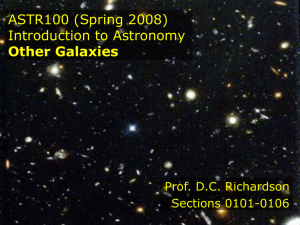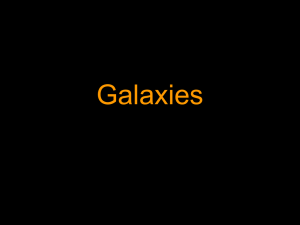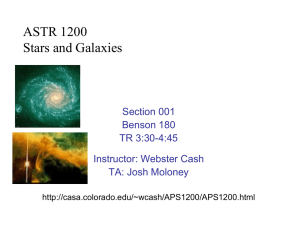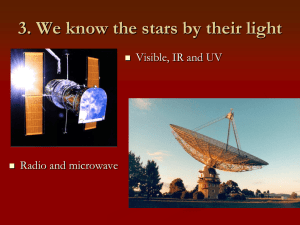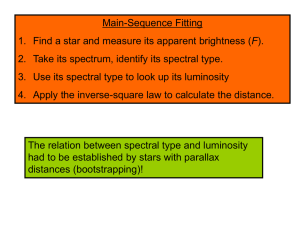Lecture 20
advertisement
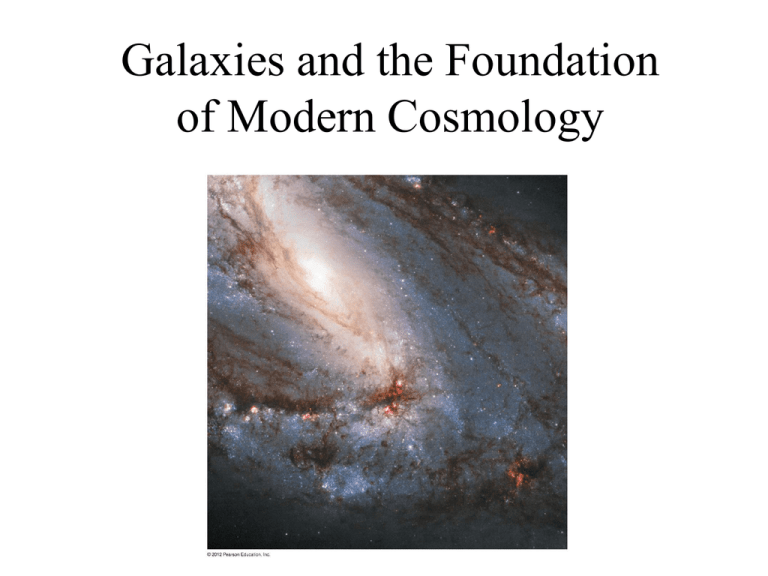
Galaxies and the Foundation of Modern Cosmology • what are the three major types of galaxies? • How are galaxies grouped together? Hubble Deep Field • Our deepest images of the universe show a great variety of galaxies, some of them billions of light-years away. Galaxies and Cosmology • A galaxy’s age, its distance, and the age of the universe are all closely related. • The study of galaxies is thus intimately connected with cosmology—the study of the structure and evolution of the universe. What are the three major types of galaxies? Spiral galaxy Disk Component: stars of all ages, many gas clouds Spheroidal Component: bulge and halo, old stars, few gas clouds Disk Component: stars of all ages, many gas clouds Spheroidal Component: bulge and halo, old stars, few gas clouds Blue-white color indicates ongoing star formation. Red-yellow color indicates older star population. Thought Question Why does ongoing star formation lead to a bluewhite appearance? A. There aren’t any red or yellow stars. B. Short-lived blue stars outshine others. C. Gas in the disk scatters blue light. Barred Spiral Galaxy: Has a bar of stars across the bulge. We few barred galaxies in the past. Bars are a sign of maturity or stability Lenticular Galaxy: Has a disk like a spiral galaxy but much less dusty gas (intermediate between spiral and elliptical). Elliptical Galaxy: All spheroidal component, virtually no disk component Red-yellow color indicates older star population. Irregular Galaxy: Neither spiral nor elliptical. Bluewhite color indicates ongoing star formation. Spheroid dominates Hubble’s galaxy classes Disk dominates How are galaxies grouped together? Spiral galaxies are often found in as groups of galaxies (up to a few dozen galaxies per group). Elliptical galaxies are much more common in huge clusters of galaxies (hundreds to thousands of galaxies). 15.2 Distances of Galaxies Our goals for learning: • How do we measure the distances to galaxies? • What is Hubble’s law? • How do distance measurements tell us the age of the universe? How do we measure the distances to galaxies? Brightness alone does not provide enough information to measure distance. Are Bright Stars Nearby or Luminous? Step 1 Determine size of solar system using radar. Radar Pulses Step 2 Determine distances of stars out to a few hundred light-years using parallax. Luminosity passing through each sphere is the same. Area of sphere: 4π (radius)2 Divide luminosity by area to get brightness. The relationship between apparent brightness and luminosity depends on distance ONLY. Brightness = Luminosity 4π (distance)2 We can determine a star’s distance if we know its luminosity and can measure its apparent brightness. Distance = Luminosity 4π Brightness A standard candle is an object whose luminosity we can determine without measuring its distance. Step 3 : Distance from cluster Main Sequence Fitting. Apparent brightness of star cluster’s main sequence tells us its distance. Pleiades is a bit less than 3 times further away than Hyades … can you see why? Hyades is close enough to measure its distance will stellar parallax, so we can use it to measure the distance to all clusters in our galaxy. Thought Question Which kind of stars are best for measuring large distances? A. High-luminosity stars B. Low-luminosity stars Thought Question Which kind of stars are best for measuring large distances? A. High-luminosity stars B. Low-luminosity stars Cepheid variable stars are very luminous. Cepheid Variable Stars The light curve of this Cepheid variable star shows that its brightness alternately rises and falls over a 50day period. Cepheid variable stars with longer periods have greater luminosities. Step 4: Using Cepheid Variables as Standard Candles Because the period of a Cepheid variable star tells us its luminosity, we can use these stars as standard candles. We can calibrate the period-luminosity relationship of Cepheid stars by measuring these in star clusters in our galaxy (recall we can measure the distance to clusters using Hyades as a baseline). Once calibrated the Cepheid period-luminosity relation can be used to determine the distances to galaxies within a few tens of mega parsecs. White dwarf supernovae can also be used as standard candles. Step 5 Apparent brightness of a white dwarf supernova tells us the distance to its galaxy (up to 10 billion lightyears). What is Hubble’s law? Hubble’s Law • We can use Hubble’s Law to determine the distance to extremely distance galaxies. • If we measure the Doppler shift we can tell from the redshift how fast a galaxy is moving away. • From the previous plot give the recession velocity we can estimate the distance. • Now work on the Galaxy Classification section of the lecture tutorial book.



